A Qualitative Study of Water Quality Using Landsat 8 and Station Water Quality-Monitoring Data to Support SDG 6.3.2 Evaluations: A Case Study of Deqing, China
Abstract
:1. Introduction
2. Study Area and Datasets
2.1. Study Area
2.2. Datasets and Preprocessing
2.2.1. Measured Water Quality Data
2.2.2. Landsat 8 Data and Preprocessing
- First, utilize the quality evaluation band that comes with the dataset, employing GEE’s built-in band logic operation function to perform cloud removal from the images.
- Through the mixed pixel decomposition method, mixed pixels with mixed features are removed to extract relatively pure water pixels. Mixed pixels contain multiple features, which makes it difficult for classifiers to decide which category to assign them to, thus lowering the accuracy of classification results [31,39]. The impurity of the pixel features interferes with data statistics and analysis, making it difficult to accurately reflect the actual situation. By using mixed pixel decomposition techniques to eliminate mixed pixels, we extract purer water body pixels, which improves the accuracy and scientific validity of the subsequent classification results [40].
- Permanent water bodies can be extracted using the time-spectral characteristics of surface features (periodic changes of spectral features in the time dimension) [41]. Seasonal changes in water bodies will cause some areas to alternate between water and land within a year, resulting in an extreme data imbalance, where some areas have less available data than other areas, affecting the accuracy of the SDG6.3.2 evaluation. By masking seasonal water bodies, this can be avoided, while also improving the accuracy of the evaluation results.
3. Methods
3.1. Remote Sensing Water Quality Sample-Enhancement Method for Synergizing Remote Sensing Data with Ground Monitoring Station Data
3.1.1. Remote Sensing Water Quality Sample Expansion Based on Rule Generation
- Retain expanded sampling points when the water quality category of the sampling time points before and after the imaging time point is consistent;
- If there is a change in the water quality category of the sampling time points before and after the imaging time point, and if the imaging time point is after the matched sampling time point and the water quality of the sampling time point is poor, retain the expanded sampling points;
- If there is a change in the water quality category of the sampling time points before and before the imaging time point, and the imaging time point is after the matched sampling time point and the water quality of the sampling time point is good, retain the expanded sampling points;
- In other cases, the expanded data will not be retained.
3.1.2. Sample Augmentation Dataset Optimization Based on Anomaly Detection
3.2. Water Quality Classification Feature Selection and Model
3.2.1. Construction and Selection Methods of Feature Variables
- Random forest sampling: This approach generates multiple decision trees to classify objects sequentially. The aggregated result of each decision tree’s classification contributes to the final category predicted by the random forest, thereby improving the classification accuracy. This process also evaluates the importance of different features bing involved in the classification [47,48]. Features whose cumulative weight are in the top 60% are selected;
- ReliefF feature selection: The ReliefF method is used for feature selection [49,50]. It starts by randomly selecting a sample, R from all training samples, then extracting k nearest neighbors from samples within the same category as R. For samples in different categories from R, k nearest neighbors are also selected. The feature’s classification ability is determined by calculating the maximum distance moved by samples of the same and different categories. Features with higher weights are considered more significant in classification. The top 60% of features, whose cumulative weight is reached, are chosen.;
- Pearson correlation coefficient: Use the Pearson correlation coefficient to screen feature parameters [51]. Calculate the person correlation coefficient between each characteristic parameter and the water quality parameter [52]. The larger the absolute value of the Pearson correlation coefficient, the stronger the correlation between the two [53]. Among the correlation coefficients between water quality parameters and features, the top ten features among each water quality parameter are selected as feature variables.
3.2.2. Model Construction
3.2.3. Accuracy Evaluation Method
3.3. Sustainable Development Goal 6.3.2 Evaluation Using Remote Sensing Water Quality Classification Results
3.3.1. Constructing Water Body Unit to Support Evolution
3.3.2. Evaluation Plan Design
- For long-term series data for a given pixel, if the standard time ratio (i.e., duration of good water quality/total duration) exceeds 80 percent, the water quality for that pixel is classified as good for the monitoring period;
- For the long-term series data of a specific water body, if the proportion of good quality water pixels (number of good quality pixels/total number of pixels) exceeds 80%, then the water quality of that water body is considered good during the monitoring period. The water quality score for the water body = (number of good quality pixels/total number of pixels) * 100;
- For the long-term series data of a certain area (e.g., a watershed or lake district), if the average water quality score of all contained water bodies exceeds 80, then the water quality of that area is considered good during the monitoring period;
- For the long-term series data of a certain region, if the average water quality score of all included areas exceeds 80, then the water quality of that region is considered good during the monitoring period.
4. Results
4.1. Sample Enhanced Statistical Results
4.2. Construction of Feature Variables
4.3. Model Training Results and Accuracy Verification
4.4. Spatiotemporal Pattern of Water Quality in Deqing County
4.5. Deqing County Water System SDG 6.3.2 Evaluation
5. Discussion
6. Conclusions
Author Contributions
Funding
Data Availability Statement
Acknowledgments
Conflicts of Interest
References
- Chen, J.Q. Global change and sustainable development of water resources. Adv. Water Sci. 1996, 7, 187–192. [Google Scholar]
- Lukhabi, D.K.; Mensah, P.K.; Asare, N.K.; Pulumuka-Kamanga, T.; Ouma, K.O. Adapted Water Quality Indices: Limitations and Potential for Water Quality Monitoring in Africa. Water 2023, 15, 1736. [Google Scholar] [CrossRef]
- Wang, Y.; He, W.; Chen, C.; Zhang, X.; Tang, H.; Li, P.; Tong, Y.; Li, M.; Lin, Y.; Yu, J.; et al. Different Countries Need Strengthen Water Management to Improve Human Health. J. Clean. Prod. 2022, 380, 134998. [Google Scholar] [CrossRef]
- United Nations Water. The United Nations World Water Development Report 2023: Partnerships and Cooperation for Water; United Nations Water: New York, NY, USA, 2023. [Google Scholar]
- United Nations. Transforming our World: The 2030 Agenda for Sustainable Development; United Nations: New York, NY, USA, 2015. [Google Scholar]
- United Nations Water. Integrated Monitoring Guide for SDG 6-Targets and Global Indicators; United Nations Water: New York, NY, USA, 2017. [Google Scholar]
- United Nations Water. Piloting the Monitoring Methodology and Initial Findings for SDG Indicator 6.3.2; United Nations Water: New York, NY, USA, 2018. [Google Scholar]
- Shen, M.; Duan, H.; Cao, Z.; Xue, K.; Qi, T.; Ma, J.; Liu, D.; Song, K.; Huang, C.; Song, X. Sentinel-3 OLCI Observations of Water Clarity in Large Lakes in Eastern China: Implications for SDG 6.3.2 Evaluation. Remote Sens. Environ. 2020, 247, 111950. [Google Scholar] [CrossRef]
- Adjovu, G.E.; Stephen, H.; James, D.; Ahmad, S. Overview of the Application of Remote Sensing in Effective Monitoring of Water Quality Parameters. Remote Sens. 2023, 15, 1938. [Google Scholar] [CrossRef]
- Qiu, R.; Wang, S.; Shi, J.; Shen, W.; Zhang, W.; Zhang, F.; Li, J. Sentinel-2 MSI Observations of Water Clarity in Inland Waters across Hainan Island and Implications for SDG 6.3.2 Evaluation. Remote Sens. 2023, 15, 1600. [Google Scholar] [CrossRef]
- Strobl, R.O.; Robillard, P.D. Network Design for Water Quality Monitoring of Surface Freshwaters: A Review. J. Environ. Manag. 2008, 87, 639–648. [Google Scholar] [CrossRef]
- Miao, J.; Song, X.; Zhong, F.; Huang, C. Sustainable Development Goal 6 Assessment and Attribution Analysis of Underdeveloped Small Regions Using Integrated Multisource Data. Remote Sens. 2023, 15, 3885. [Google Scholar] [CrossRef]
- Gholizadeh, M.H.; Melesse, A.M.; Reddi, L. A Comprehensive Review on Water Quality Parameters Estimation Using Remote Sensing Techniques. Sensors 2016, 16, 1298. [Google Scholar] [CrossRef]
- Topp, S.N.; Pavelsky, T.M.; Jensen, D.; Simard, M.; Ross, M.R.V. Research Trends in the Use of Remote Sensing for Inland Water Quality Science: Moving Towards Multidisciplinary Applications. Water 2020, 12, 169. [Google Scholar] [CrossRef]
- Odermatt, D.; Gitelson, A.; Brando, V.E.; Schaepman, M. Review of Constituent Retrieval in Optically Deep and Complex Waters from Satellite Imagery. Remote Sens. Environ. 2012, 118, 116–126. [Google Scholar] [CrossRef]
- Ahmed, W.; Mohammed, S.; El-Shazly, A.; Morsy, S. Tigris River Water Surface Quality Monitoring Using Remote Sensing Data and GIS Techniques. Egypt. J. Remote Sens. Space Sci. 2023, 26, 816–825. [Google Scholar] [CrossRef]
- Li, J.; Yu, Q.; Tian, Y.Q.; Becker, B.L.; Siqueira, P.; Torbick, N. Spatio-Temporal Variations of CDOM in Shallow Inland Waters from a Semi-Analytical Inversion of Landsat-8. Remote Sens. Environ. 2018, 218, 189–200. [Google Scholar] [CrossRef]
- Rahat, S.H.; Steissberg, T.; Chang, W.; Chen, X.; Mandavya, G.; Tracy, J.; Wasti, A.; Atreya, G.; Saki, S.; Bhuiyan, M.A.E.; et al. Remote Sensing-Enabled Machine Learning for River Water Quality Modeling under Multidimensional Uncertainty. Sci. Total Environ. 2023, 898, 165504. [Google Scholar] [CrossRef]
- Campbell, G.; Phinn, S.R.; Dekker, A.G.; Brando, V.E. Remote Sensing of Water Quality in an Australian Tropical Freshwater Impoundment Using Matrix Inversion and MERIS Images. Remote Sens. Environ. 2011, 115, 2402–2414. [Google Scholar] [CrossRef]
- Xie, Y.; Zhou, Q.; Xiao, X.; Chen, F.; Huang, Y.; Kang, J.; Wang, S.; Zhang, F.; Gao, M.; Du, Y.; et al. Satellite-Based Water Quality Assessment of the Beijing Section of the Grand Canal: Implications for SDG11.4 Evaluation. Remote Sens. 2024, 16, 909. [Google Scholar] [CrossRef]
- Ruben, G.B.; Zhang, K.; Bao, H.; Ma, X. Application and Sensitivity Analysis of Artificial Neural Network for Prediction of Chemical Oxygen Demand. Water Resour. Manag. 2018, 32, 273–283. [Google Scholar] [CrossRef]
- Zhou, Y.; Yu, D.; Yang, Q.; Pan, S.; Gai, Y.; Cheng, W.; Liu, X.; Tang, S. Variations of Water Transparency and Impact Factors in the Bohai and Yellow Seas from Satellite Observations. Remote Sens. 2021, 13, 514. [Google Scholar] [CrossRef]
- Wang, H.; Wu, M.A.; Zhou, Y.Y.; Xia, K.; Tang, Y.; Zhang, W. Influence of Field Environmental Factors on Water Transparency. Adv. Mater. Res. 2014, 1030–1032, 532–538. [Google Scholar] [CrossRef]
- Feng, L.; Hou, X.; Zheng, Y. Monitoring and Understanding the Water Transparency Changes of Fifty Large Lakes on the Yangtze Plain Based on Long-Term MODIS Observations. Remote Sens. Environ. 2019, 221, 675–686. [Google Scholar] [CrossRef]
- Kaya, Y.; Sanli, F.B.; Abdikan, S. Determination of Long-Term Volume Change in Lakes by Integration of UAV and Satellite Data: The Case of Lake Burdur in Türkiye. Environ. Sci. Pollut. Res. 2023, 30, 117729–117747. [Google Scholar] [CrossRef]
- Zhang, H.; Zhou, J.; Huangfu, K. Analysis on water quality monitoring indicators by remote sensing based on OLl data: A case of Huaihe River Basin in Xinyang City. Yangtze River 2021, 52, 47–53. [Google Scholar]
- Kolokoussis, P.; Karathanassi, V. Detection of Oil Spills and Underwater Natural Oil Outflow Using Multispectral Satellite Imagery. Int. J. Remote Sens. Appl. 2013, 3, 145–154. [Google Scholar]
- Vakili, T.; Amanollahi, J. Determination of Optically Inactive Water Quality Variables Using Landsat 8 Data: A Case Study in Geshlagh Reservoir Affected by Agricultural Land Use. J. Clean. Prod. 2020, 247, 119134. [Google Scholar] [CrossRef]
- Najafzadeh, M.; Basirian, S. Evaluation of River Water Quality Index Using Remote Sensing and Artificial Intelligence Models. Remote Sens. 2023, 15, 2359. [Google Scholar] [CrossRef]
- Choi, M.; Hur, Y. A Microwave-Optical/Infrared Disaggregation for Improving Spatial Representation of Soil Moisture Using AMSR-E and MODIS Products. Remote Sens. Environ. 2012, 124, 259–269. [Google Scholar] [CrossRef]
- Xiao, Y.; Chen, J.; Xu, Y.; Guo, S.; Nie, X.; Guo, Y.; Li, X.; Hao, F.; Fu, Y.H. Monitoring of Chlorophyll-a and Suspended Sediment Concentrations in Optically Complex Inland Rivers Using Multisource Remote Sensing Measurements. Ecol. Indic. 2023, 155, 111041. [Google Scholar] [CrossRef]
- Chen, S.; Hu, C.; Barnes, B.B.; Xie, Y.; Lin, G.; Qiu, Z. Improving Ocean Color Data Coverage through Machine Learning. Remote Sens. Environ. 2019, 222, 286–302. [Google Scholar] [CrossRef]
- Yang, L.; Driscol, J.; Sarigai, S.; Wu, Q.; Lippitt, C.D.; Morgan, M. Towards Synoptic Water Monitoring Systems: A Review of AI Methods for Automating Water Body Detection and Water Quality Monitoring Using Remote Sensing. Sensors 2022, 22, 2416. [Google Scholar] [CrossRef]
- Maťašovská, V.; Kothan, F.; Ledvinka, O.; Pumann, P.; Fojtík, T.; Makovcová, M.; Bendakovská, L. Využití metod dálkového průzkumu Země pro monitoring stavu koupacích míst. Vodohospodářské Tech. Ekon. Inf. 2021, 63, 37–45. [Google Scholar] [CrossRef]
- El Serafy, G.Y.H.; Schaeffer, B.A.; Neely, M.-B.; Spinosa, A.; Odermatt, D.; Weathers, K.C.; Baracchini, T.; Bouffard, D.; Carvalho, L.; Conmy, R.N.; et al. Integrating Inland and Coastal Water Quality Data for Actionable Knowledge. Remote Sens. 2021, 13, 2899. [Google Scholar] [CrossRef] [PubMed]
- Yang, H.; Kong, J.; Hu, H.; Du, Y.; Gao, M.; Chen, F. A Review of Remote Sensing for Water Quality Retrieval: Progress and Challenges. Remote Sens. 2022, 14, 1770. [Google Scholar] [CrossRef]
- Peterson, K.T.; Sagan, V.; Sloan, J.J. Deep Learning-Based Water Quality Estimation and Anomaly Detection Using Landsat-8/Sentinel-2 Virtual Constellation and Cloud Computing. GIScience Remote Sens. 2020, 57, 510–525. [Google Scholar] [CrossRef]
- Smith, V.H.; Joye, S.B.; Howarth, R.W. Eutrophication of Freshwater and Marine Ecosystems. Limnol. Oceanogr. 2006, 51 Pt 2, 351–355. [Google Scholar] [CrossRef]
- Zhao, D.; Lv, M.; Zou, X.; Wang, P.; Yang, T.; An, S. What Is the Minimum River Width for the Estimation of Water Clarity Using Medium-Resolution Remote Sensing Images? Water Resour. Res. 2014, 50, 3764–3775. [Google Scholar] [CrossRef]
- Lu, D.; Moran, E.; Batistella, M. Linear Mixture Model Applied to Amazonian Vegetation Classification. Remote Sens. Environ. 2003, 87, 456–469. [Google Scholar] [CrossRef]
- Duan, M.D.; Chen, H.; Peng, H.H.; Tan, C.M.; Xia, H.N.; Shi, Q. Seasonal wetlands extraction based on the typical characteristics of land and water alternation: A case study of East Dongting Lake. Remote Sens. Technol. Appl. 2024, 1–12. [Google Scholar]
- Liu, F.T.; Ting, K.M.; Zhou, Z.-H. Isolation Forest. In Proceedings of the IEEE International Conference on Data Mining, Pisa, Italy, 15–19 December 2008; pp. 413–422. [Google Scholar]
- Chabchoub, Y.; Togbe, M.U.; Boly, A.; Chiky, R. An In-Depth Study and Improvement of Isolation Forest. IEEE Access 2022, 10, 10219–10237. [Google Scholar] [CrossRef]
- Al Farizi, W.S.; Hidayah, I.; Rizal, M.N. Isolation Forest Based Anomaly Detection: A Systematic Literature Review. In Proceedings of the 2021 8th International Conference on Information Technology, Computer and Electrical Engineering (ICITACEE), Semarang, Indonesia, 23–24 September 2021; pp. 118–122. [Google Scholar]
- Papoutsa, C.; Akylas, E.; Hadjimitsis, D. Trophic State Index Derivation through the Remote Sensing of Case-2 Water Bodies in the Mediterranean Region. Open Geosci. 2014, 6, 67–78. [Google Scholar] [CrossRef]
- Guo, Q.L.; Li, J.L.; Guo, P. Extraction of Peanut Planting Area Based on Dual-temporal Remote Sensing Features of Crops. J. Appl. Meteorol. Sci. 2022, 33, 218–230. [Google Scholar]
- Breiman, L. Random Forests. Mach. Learn. 2001, 45, 5–32. [Google Scholar] [CrossRef]
- Genuer, R.; Poggi, J.-M.; Tuleau-Malot, C. Variable Selection Using Random Forests. Pattern Recognit. Lett. 2010, 31, 2225–2236. [Google Scholar] [CrossRef]
- Wang, Z.; Zhang, Y.; Chen, Z.; Yang, H.; Sun, Y.; Kang, J.; Yang, Y.; Liang, X. Application of ReliefF Algorithm to Selecting Feature Sets for Classification of High Resolution Remote Sensing Image. In Proceedings of the IEEE International Geoscience and Remote Sensing Symposium (IGARSS), Beijing, China, 10–15 July 2016; pp. 755–758. [Google Scholar]
- Urbanowicz, R.J.; Meeker, M.; La Cava, W.; Olson, R.S.; Moore, J.H. Relief-Based Feature Selection: Introduction and Review. J. Biomed. Inform. 2018, 85, 189–203. [Google Scholar] [CrossRef] [PubMed]
- Mei, K.; Tan, M.; Yang, Z.; Shi, S. Modeling of Feature Selection Based on Random Forest Algorithm and Pearson Correlation Coefficient. J. Phys. Conf. Ser. 2022, 2219, 012046. [Google Scholar] [CrossRef]
- Yigit Avdan, Z.; Kaplan, G.; Goncu, S.; Avdan, U. Monitoring the Water Quality of Small Water Bodies Using High-Resolution Remote Sensing Data. ISPRS Int. J. Geo-Inf. 2019, 8, 553. [Google Scholar] [CrossRef]
- Zhu, H.; You, X.; Liu, S. Multiple Ant Colony Optimization Based on Pearson Correlation Coefficient. IEEE Access 2019, 7, 61628–61638. [Google Scholar] [CrossRef]
- Dong, L.; Du, H.; Mao, F.; Han, N.; Li, X.; Zhou, G.; Zhu, D.; Zheng, J.; Zhang, M.; Xing, L.; et al. Very High Resolution Remote Sensing Imagery Classification Using a Fusion of Random Forest and Deep Learning Technique—Subtropical Area for Example. IEEE J. Sel. Top. Appl. Earth Obs. Remote Sens. 2020, 13, 113–128. [Google Scholar] [CrossRef]
- Zhang, T.; Su, J.; Xu, Z.; Luo, Y.; Li, J. Sentinel-2 Satellite Imagery for Urban Land Cover Classification by Optimized Random Forest Classifier. Appl. Sci. 2021, 11, 543. [Google Scholar] [CrossRef]
- Yu, R.; Zhang, K.; Ramasubramanian, B.; Jiang, S.; Ramakrishna, S.; Tang, Y. Ensemble Learning for Predicting Average Thermal Extraction Load of a Hydrothermal Geothermal Field: A Case Study in Guanzhong Basin, China. Energy 2024, 296, 131146. [Google Scholar] [CrossRef]
- Rodriguez-Galiano, V.F.; Chica-Olmo, M.; Abarca-Hernandez, F.; Atkinson, P.M.; Jeganathan, C. Random Forest Classification of Mediterranean Land Cover Using Multi-Seasonal Imagery and Multi-Seasonal Texture. Remote Sens. Environ. 2012, 121, 93–107. [Google Scholar] [CrossRef]
- Gislason, P.O.; Benediktsson, J.A.; Sveinsson, J.R. Random Forest Classification of Multisource Remote Sensing and Geographic Data. In Proceedings of the IEEE International Geoscience and Remote Sensing Symposium, Anchorage, AK, USA, 20–24 September 2004; Volume 2, pp. 1049–1052. [Google Scholar]
- Pal, M. Random Forest Classifier for Remote Sensing Classification. Int. J. Remote Sens. 2007, 26, 217–222. [Google Scholar] [CrossRef]
- Liu, Y.; Gong, W.; Hu, X.; Gong, J. Forest Type Identification with Random Forest Using Sentinel-1A, Sentinel-2A, Multi-Temporal Landsat-8 and DEM Data. Remote Sens. 2018, 10, 946. [Google Scholar] [CrossRef]
- Fontanari, T.; Fróes, T.C.; Recamonde-Mendoza, M. Cross-Validation Strategies for Balanced and Imbalanced Datasets. In Intelligent Systems; Xavier-Junior, J.C., Rios, R.A., Eds.; Springer International Publishing: Cham, Switzerland, 2022; pp. 626–640. [Google Scholar]
- Adagbasa, E.G.; Adelabu, S.A.; Okello, T.W. Application of Deep Learning with Stratified K-Fold for Vegetation Species Discrimation in a Protected Mountainous Region Using Sentinel-2 Image. Geocarto Int. 2022, 37, 142–162. [Google Scholar] [CrossRef]
- United Nations Water. An Introduction to SDG Indicator 6.3.2: Proportion of Bodies of Water with Good Ambient Water Quality; United Nations Water: New York, NY, USA, 2023. [Google Scholar]
- Wen, Y.Z.; Lu, Y.Q.; Jin, C.; Chen, B.W.; Yang, Z.C. Regionalization of water environmental pressure and risk regions in Deqing county. Resour. Environ. Yangtze Basin 2016, 25, 981–988. [Google Scholar]
- United Nations Water. The United Nations World Water Development Report 2024: Water for Prosperity and Peace; United Nations Water: New York, NY, USA, 2024. [Google Scholar]
- Food and Agriculture Organization of the United Nations. Water Pollution from Agriculture: A Global Review; Food and Agriculture Organization of the United Nations: Rome, Italy, 2017. [Google Scholar]
- Evans, A.E.; Mateo-Sagasta, J.; Qadir, M.; Boelee, E.; Ippolito, A. Agricultural Water Pollution: Key Knowledge Gaps and Research Needs. Curr. Opin. Environ. Sustain. 2019, 36, 20–27. [Google Scholar] [CrossRef]
- Moss, B. Water Pollution by Agriculture. Philos. Trans. R. Soc. B Biol. Sci. 2007, 363, 659–666. [Google Scholar] [CrossRef] [PubMed]
- Rajesh, A.; Jiji, G.W.; Raj, J.D. Estimating the Pollution Level Based on Heavy Metal Concentration in Water Bodies of Tiruppur District. J. Indian Soc. Remote Sens. 2020, 48, 47–57. [Google Scholar] [CrossRef]
- Chen, C.; Liu, F.; He, Q.; Shi, H. The Possibility on Estimation of Concentration of Heavy Metals in Coastal Waters from Remote Sensing Data. In Proceedings of the IEEE International Geoscience and Remote Sensing Symposium, Honolulu, HI, USA, 25–30 July 2010; pp. 4216–4219. [Google Scholar]
- Liang, Y.H.; Deng, R.R.; Gao, Y.K.; Qin, Y.; Liu, X.L. Measuring absorption coefficient spectrum (400–900 nm) of copper ions in water. Natl. Remote Sens. Bull. 2016, 20, 27–34. [Google Scholar]
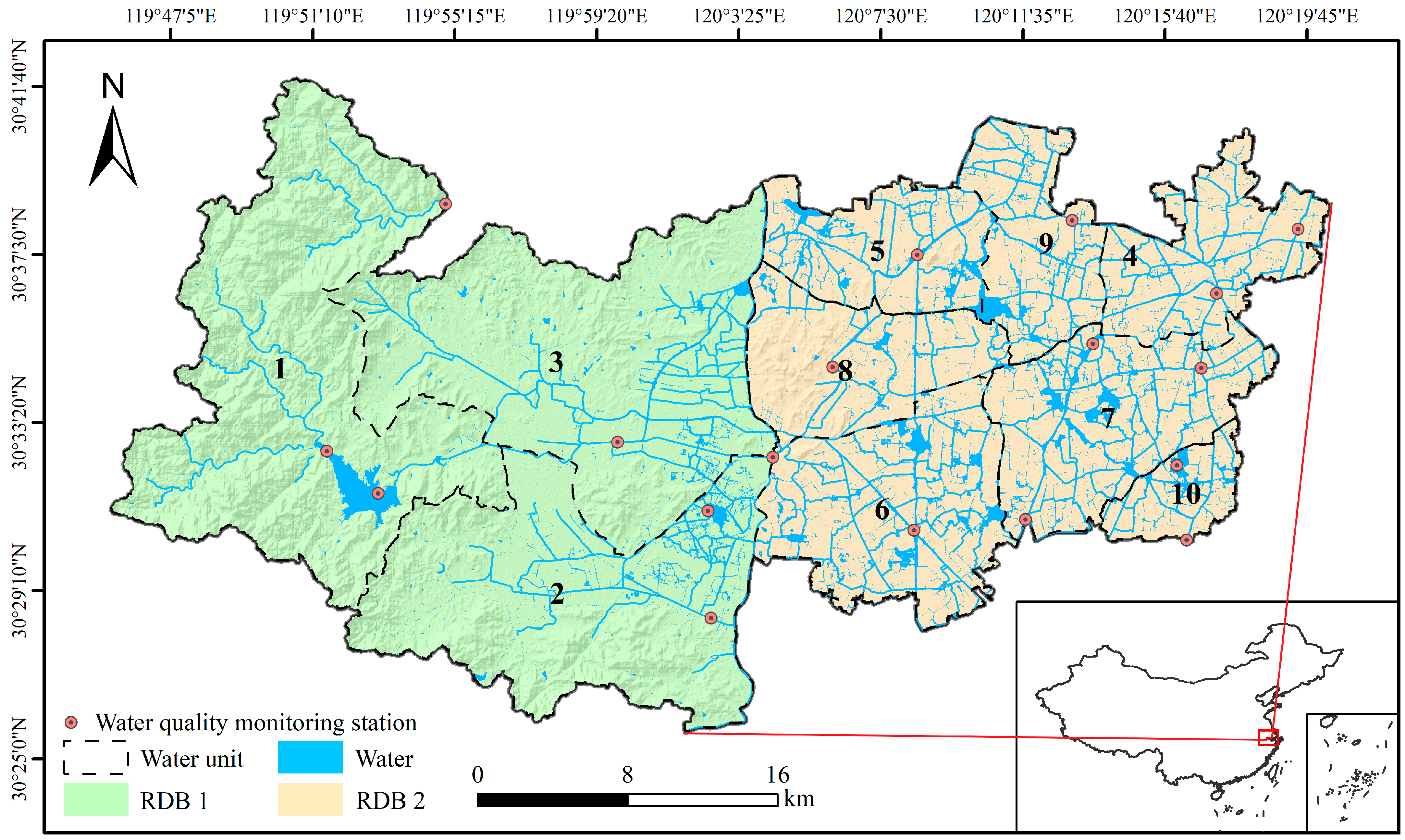



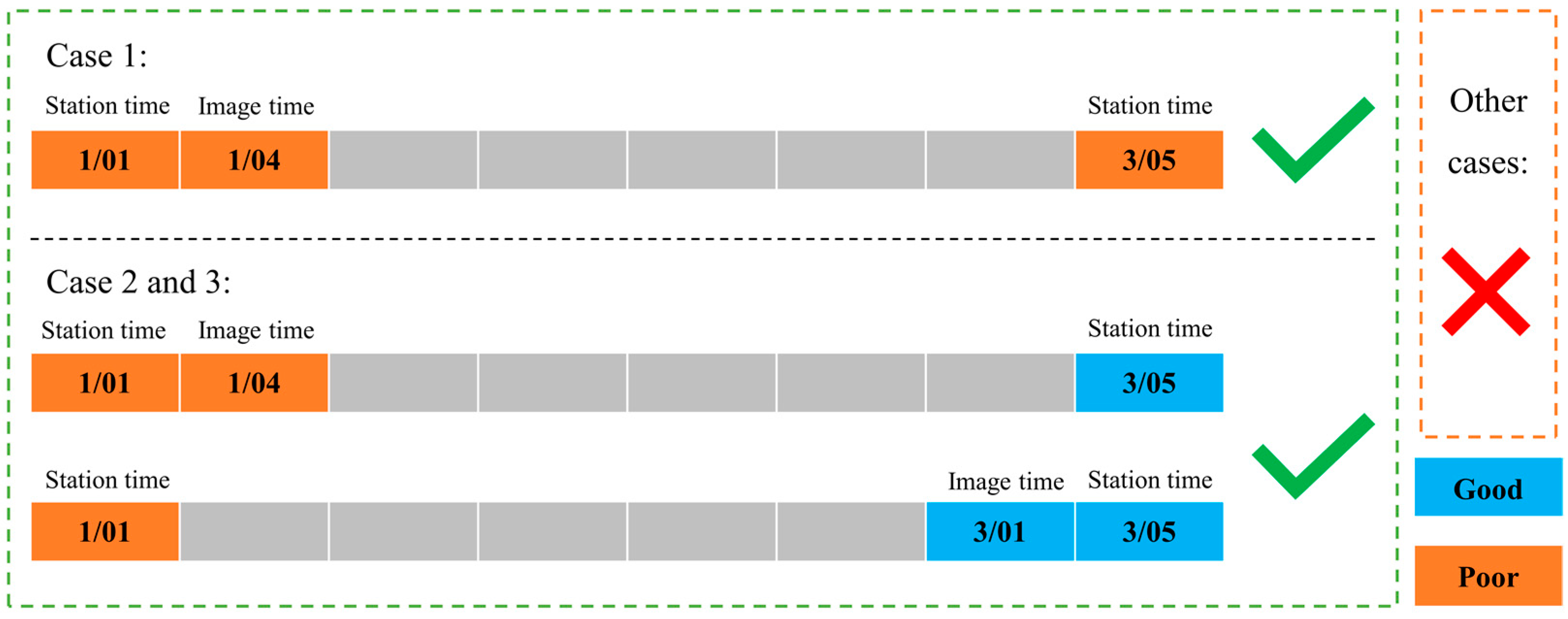

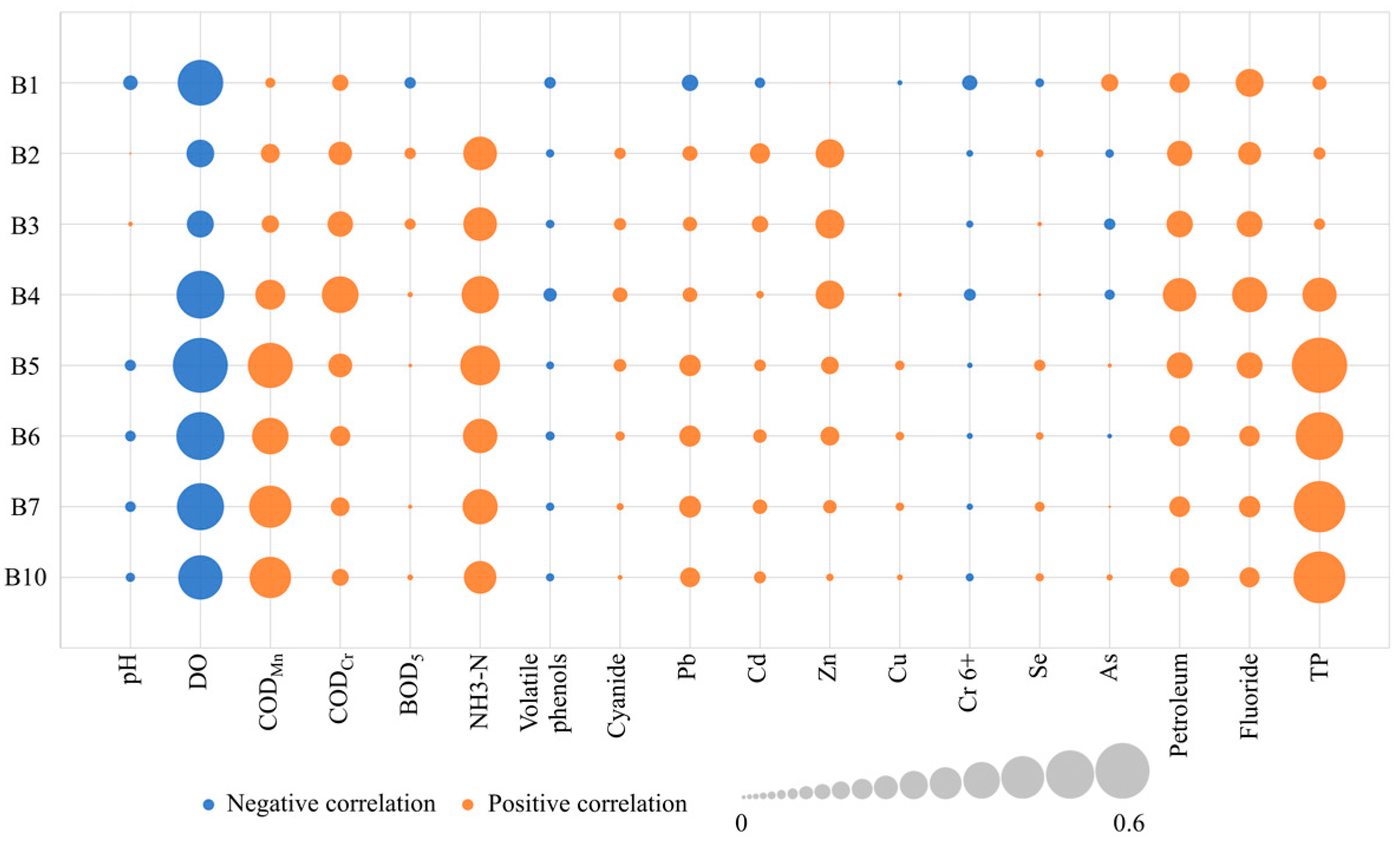

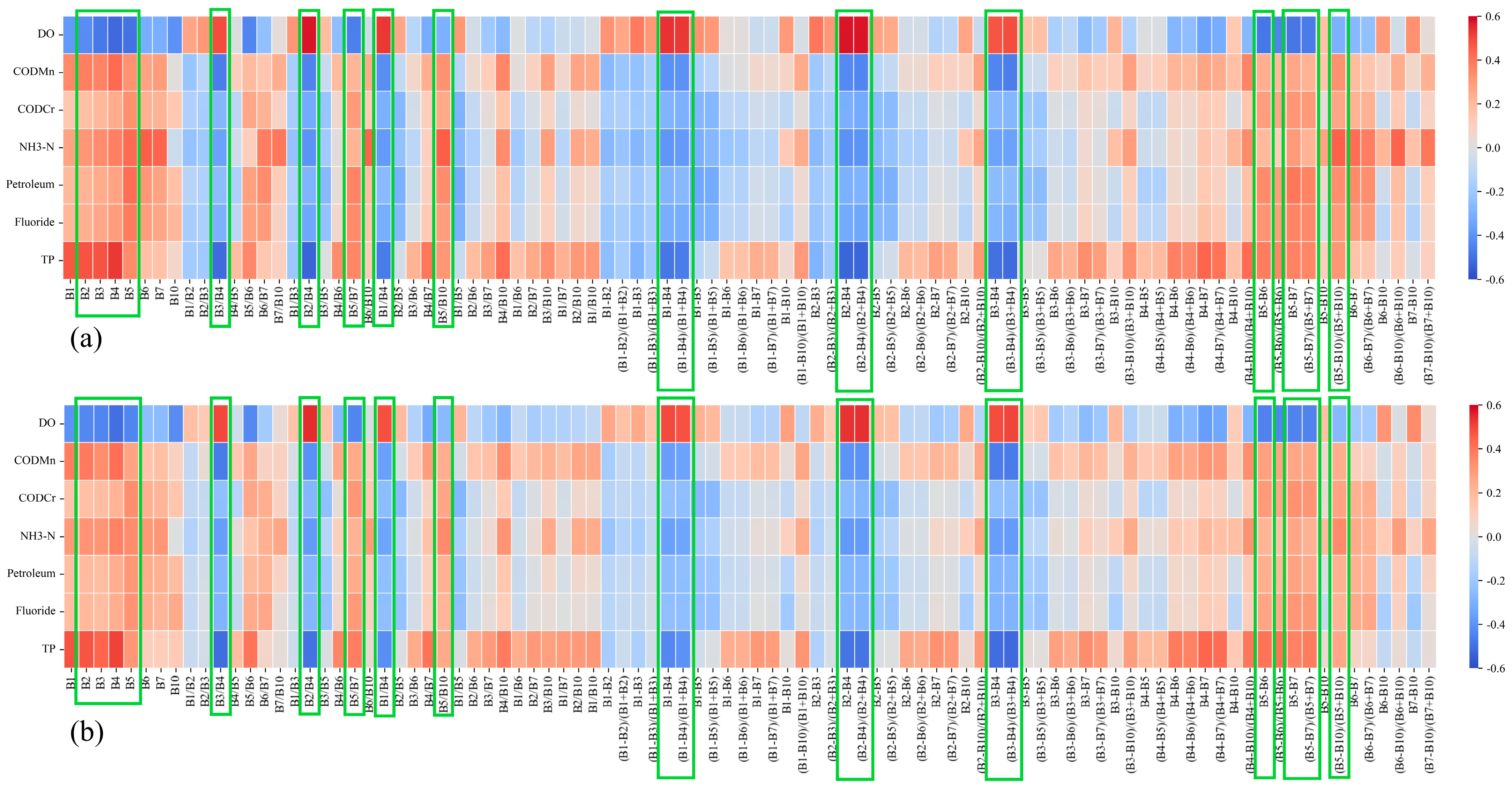
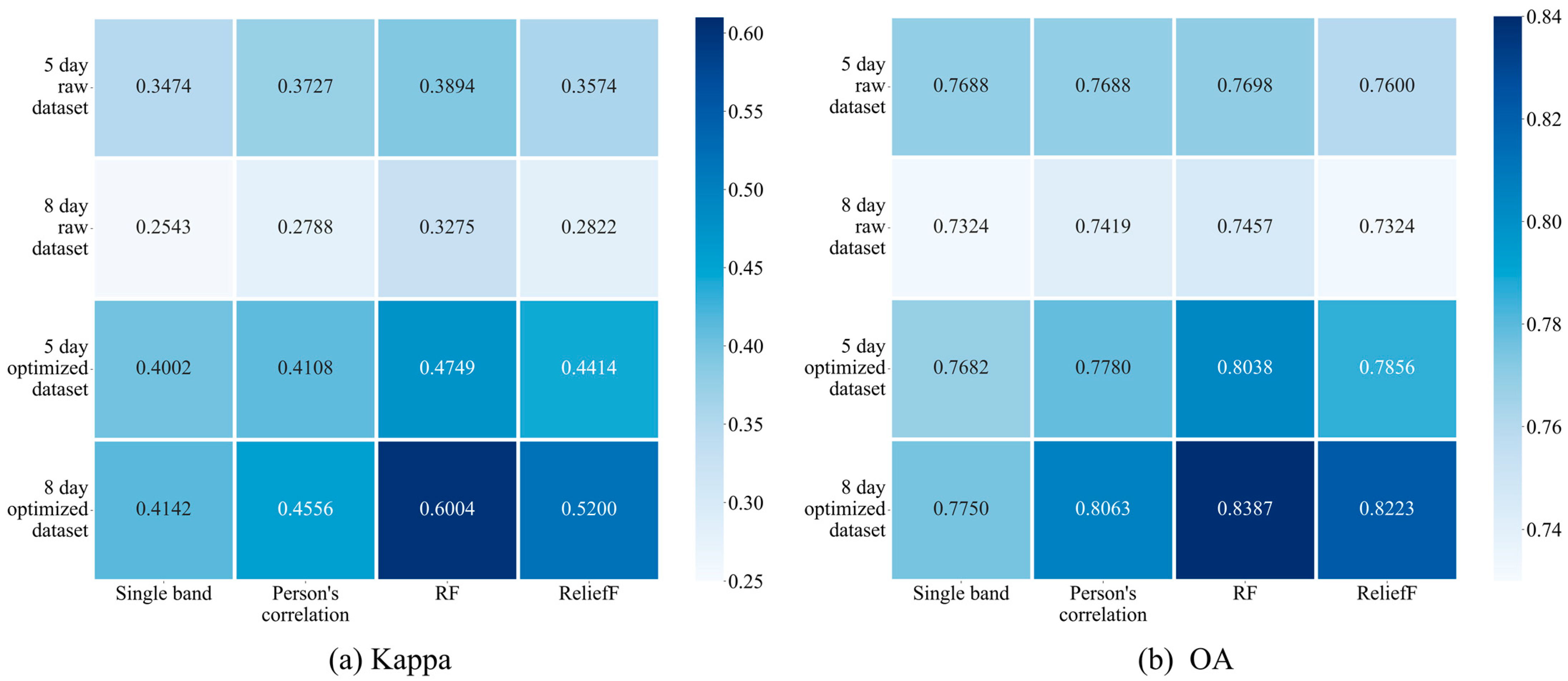

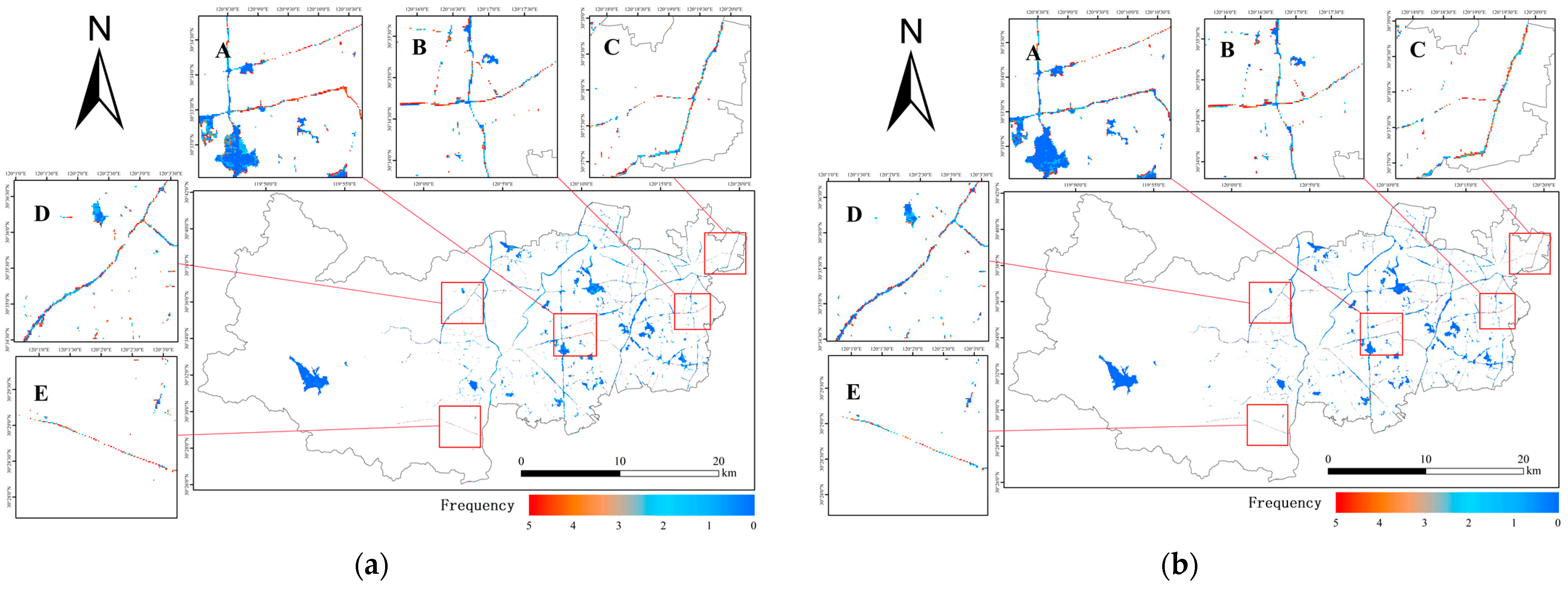
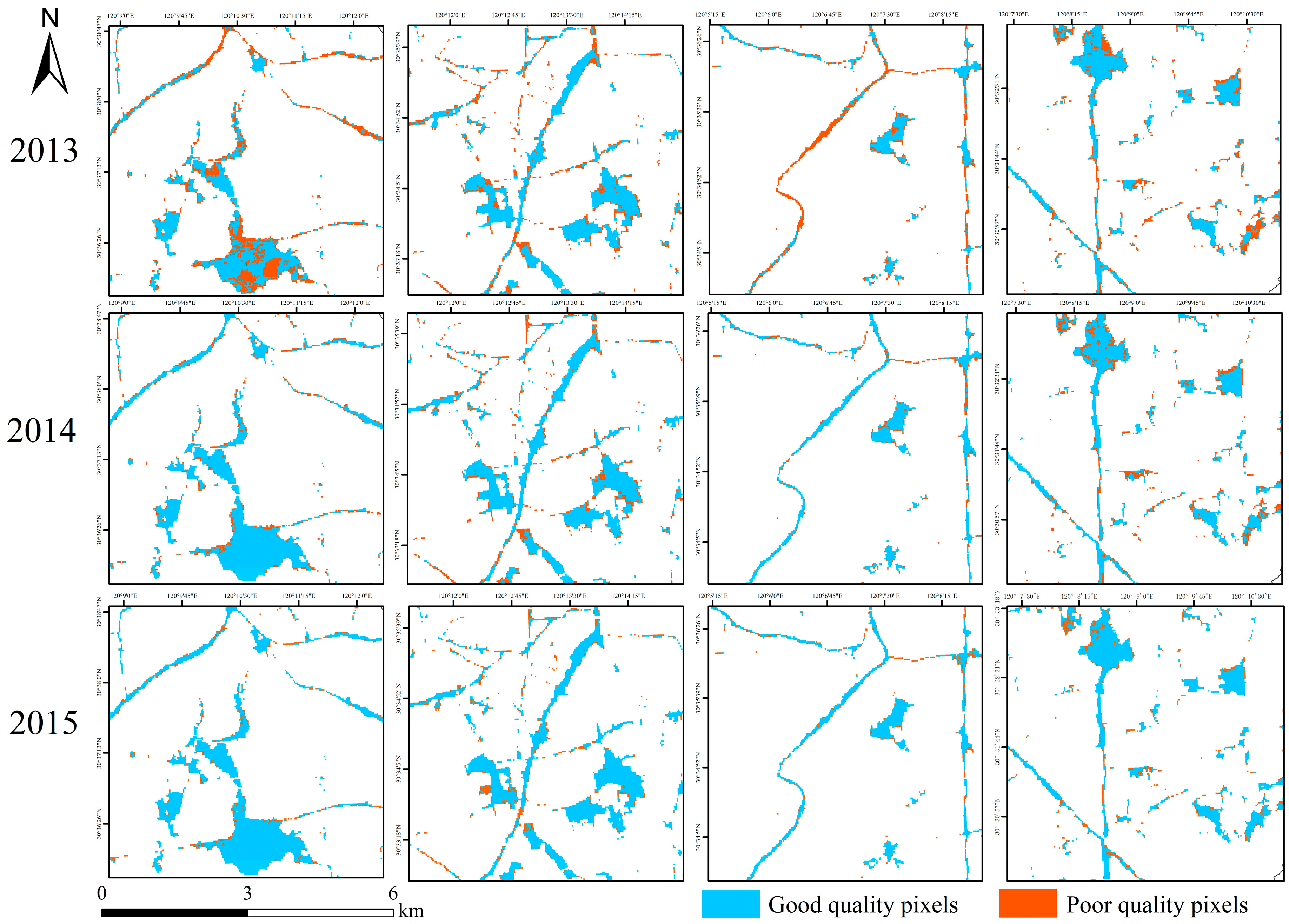

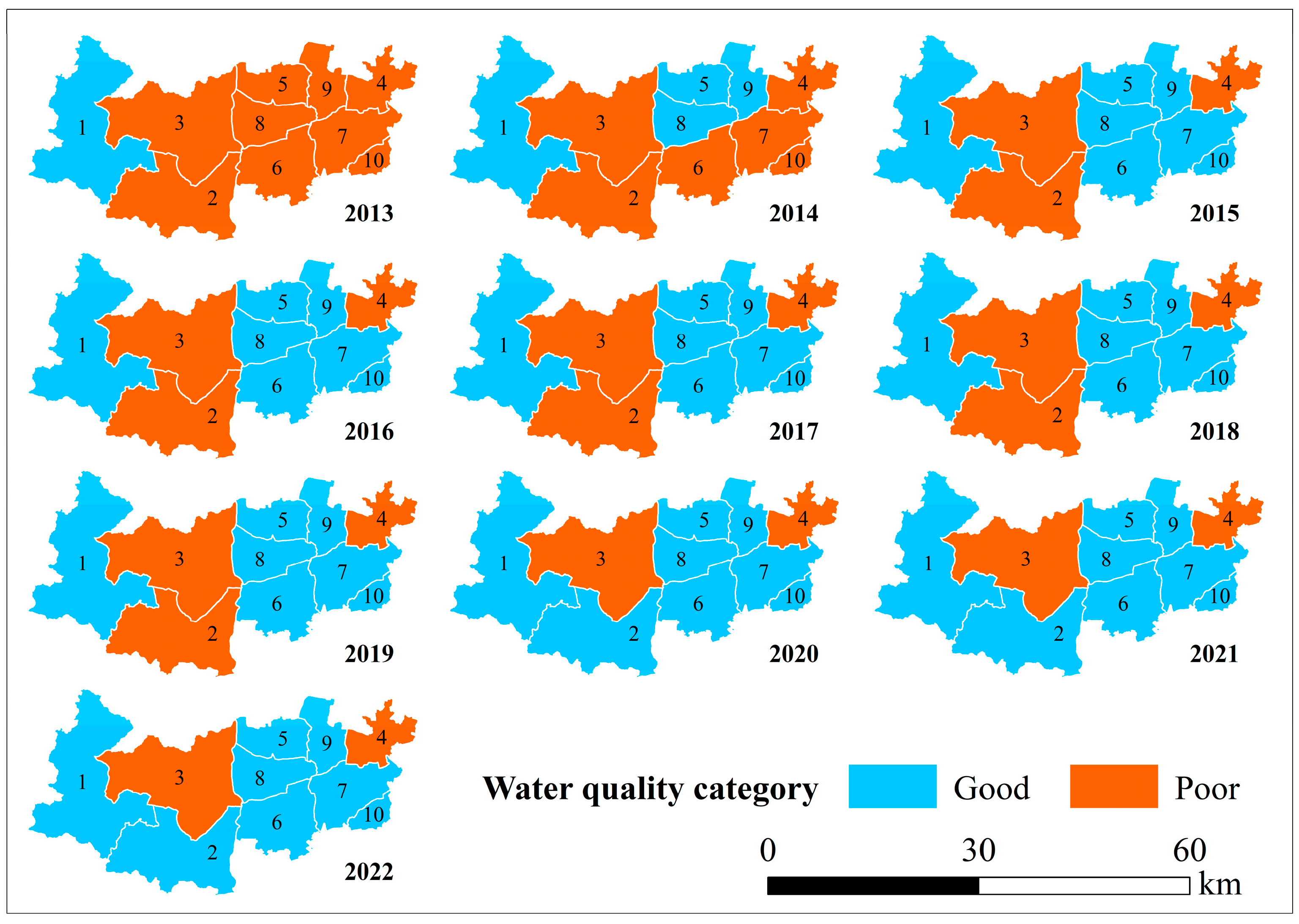
| Feature | Calculation Formula | Amount |
|---|---|---|
| Single band | Bi | 8 |
| Band difference | Bi − Bj | 28 |
| Band ratio | Bi/Bj | 28 |
| Normalized band ratio | (Bi − Bj)/(Bi + Bj) | 28 |
| Extended Time Window | Total Amount of Data | Good Water Quality Data Volume | Poor Water Quality Data Volume |
|---|---|---|---|
| The day | 6 | 6 | 0 |
| ±1-day time window | 11 | 11 | 0 |
| ±2-day time window | 53 | 40 | 13 |
| ±3-day time window | 67 | 52 | 15 |
| ±4-day time window | 96 | 71 | 25 |
| ±5-day time window | 112 | 86 | 26 |
| ±6-day time window | 116 | 90 | 26 |
| ±7-day time window | 142 | 110 | 32 |
| ±8-day time window | 144 | 110 | 34 |
| Feature Optimization Method | Sample Expansion Plan | Whether to Optimize |
|---|---|---|
| Single band | ±5-day time window | Yes |
| ±8-day time window | No | |
| Pearson correlation coefficient | ±5-day time window | Yes |
| ±8-day time window | No | |
| Random forest | ±5-day time window | Yes |
| ±8-day time window | No | |
| ReliefF | ±5-day time window | Yes |
| ±8-day time window | No |
| DO (mg/L) | CODMn (mg/L) | CODCr (mg/L) | NH3-N (mg/L) | Petroleum (mg/L) | Fluoride (mg/L) | TP (mg/L) | Sampling Times | |
|---|---|---|---|---|---|---|---|---|
| Target value for good water | >=5 | <=6 | <=20 | <=1 | <=0.5 | <=1 | <=0.2 | |
| 2013 | 5.580 | 4.409 | 20.073 | 1.142 | 0.044 | 0.492 | 0.170 | 114 |
| 2014 | 6.391 | 4.369 | 18.076 | 1.018 | 0.043 | 0.416 | 0.125 | 114 |
| 2015 | 6.464 | 3.965 | 15.368 | 0.532 | 0.041 | 0.419 | 0.112 | 112 |
Disclaimer/Publisher’s Note: The statements, opinions and data contained in all publications are solely those of the individual author(s) and contributor(s) and not of MDPI and/or the editor(s). MDPI and/or the editor(s) disclaim responsibility for any injury to people or property resulting from any ideas, methods, instructions or products referred to in the content. |
© 2024 by the authors. Licensee MDPI, Basel, Switzerland. This article is an open access article distributed under the terms and conditions of the Creative Commons Attribution (CC BY) license (https://creativecommons.org/licenses/by/4.0/).
Share and Cite
Chen, H.; Tan, C.; Peng, H.; Yang, W.; Li, L. A Qualitative Study of Water Quality Using Landsat 8 and Station Water Quality-Monitoring Data to Support SDG 6.3.2 Evaluations: A Case Study of Deqing, China. Water 2024, 16, 1319. https://doi.org/10.3390/w16101319
Chen H, Tan C, Peng H, Yang W, Li L. A Qualitative Study of Water Quality Using Landsat 8 and Station Water Quality-Monitoring Data to Support SDG 6.3.2 Evaluations: A Case Study of Deqing, China. Water. 2024; 16(10):1319. https://doi.org/10.3390/w16101319
Chicago/Turabian StyleChen, Hao, Changmiao Tan, Huanhua Peng, Wentao Yang, and Lelin Li. 2024. "A Qualitative Study of Water Quality Using Landsat 8 and Station Water Quality-Monitoring Data to Support SDG 6.3.2 Evaluations: A Case Study of Deqing, China" Water 16, no. 10: 1319. https://doi.org/10.3390/w16101319
APA StyleChen, H., Tan, C., Peng, H., Yang, W., & Li, L. (2024). A Qualitative Study of Water Quality Using Landsat 8 and Station Water Quality-Monitoring Data to Support SDG 6.3.2 Evaluations: A Case Study of Deqing, China. Water, 16(10), 1319. https://doi.org/10.3390/w16101319







